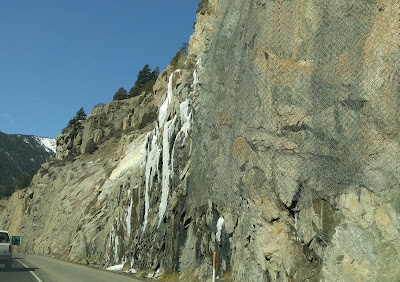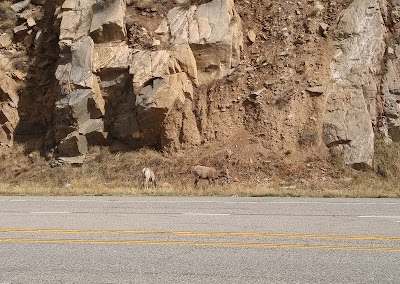Not surprisingly, I felt that way last April on the final day of our trip to Colorado. We all had flights home that afternoon, but as John Muir said, the mountains were calling, and we had to go. Since we needed to stay in the vicinity of Denver, the easiest way to experience mountains was to drive out I-70 a ways. Happily, this is also a spectacularly scenic route; I-70 between Denver and Grand Junction in western Colorado is probably the most beautiful stretch of interstate in the whole country. So we rolled out early and set off west from Aurora.
Both my sister and I had made the drive east from Grand Junction to Denver in 2010, but we'd never had the experience of going the other direction. And my sister's boyfriend had never seen the mountains up close, so we all felt we were in for a treat.
The trip across town into the foothills beyond Golden didn't take much more than 30 minutes, and after a few miles of climbing, we reached our first clear view of snow-capped peaks framed perfectly by the Genesee Trail Road bridge as we crested a rise.
Our goal for the morning was to reach the Continental Divide via Loveland Pass and the Eisenhower Tunnel, a road that would take us right through the snowy peaks in front of us.
We still had some 40 miles to traverse however...
...through the former mining town of Idaho Springs...
...and winding through incredible rock formations.
The temperature was quite pleasant at lower elevations...
...but winter still had a firm grip the higher we climbed.
...and Mt. Bethel to the north.
The snow on the mountains under bright sun was sublime.
Up, up, up we went, nearly to the tree line.
And into the tunnel! As we drove though, we crossed the Continental Divide and reached an elevation of 11,158 feet, the highest point on the Interstate Highway System (and nearly 6,000 feet higher than where we started the day).
When we popped out on the other side, the road was still wet from freshly fallen snow that was melting in the morning sun.
I would have loved to go out as far as Glenwood Canyon, but having flights to catch meant we needed to turn around at the next exit and head back.
We enjoyed views of Buffalo Mountain as we descended into Silverthorne.
Buffalo Mountain (below, left) and Red Peak (below, right) loom over the small town of Silverthorne which interestingly was named for a person rather than the precious metal. Though some mining took place in the area, the town mostly owes its existence to the nearby Dillon reservoir and to skiers.
We stayed only long enough to put a little gas in the car and then headed back east.
The scenery was of course incredible in both directions.
The tunnel on the western side of the pass is pretty much even with the tree line...
...and is slightly below it when you emerge on the other side.
Just outside of Georgetown, we stopped at an overlook to see the Georgetown Loop, a narrow gauge railroad trestle that is part of a line between Georgetown and Silver Plume. They are only two miles apart, but Silver Plume sits some 600 feet higher than Georgetown, hence the long sweeping curves and loops of track to connect the two towns at a reasonable grade.
 |
| Looking back up the valley toward Silver Plume |
 |
| Both the sign and the stickers were interesting. |
...and the various quirky points of interest along the way.
As much as I love the mountains and high passes, I find the rolling green foothills of the Rockies compelling as well.
There's something about the contrast of the landscape against that wide-open sky that makes my heart sing. I don't know how anyone can visit this place and not fall irrevocably in love.
My ties to Colorado and the mountains are tenuous at best---my great-grandparents and their parents and siblings ran sheep in a tiny town nestled in a valley behind the Front Range. Distant cousins of mine still live there in the house my great-great-grandparents built, and more than a few of my ancestors died and were buried in Colorado. So I do have roots there after a fashion. The line in John Denver's song Rocky Mountain High about coming home to a place you've never been before has always a struck a chord with me (no pun intended) for this reason.
This last year since taking the trip to Colorado has largely been one of upheaval and unhappiness for me, and I find myself more than ever adrift and longing to finally settle somewhere I love for good. Chicago has never been home to me despite nearly twenty years living here, and I'm tired of not having a place to really call my own. I don't know if I can afford to move to Colorado anymore---New Mexico is looking like a smarter option in terms of cost of living---but wherever I end up, there must be mountains. Because John Muir was right. Going to the mountains is going home.
Wilderness is not a luxury but a necessity of the human spirit.
Read more at: https://www.brainyquote.com/quotes/edward_abbey_383238
Read more at: https://www.brainyquote.com/quotes/edward_abbey_383238
Wilderness is not a luxury but a necessity of the human spirit.
Read more at: https://www.brainyquote.com/quotes/edward_abbey_383238
Read more at: https://www.brainyquote.com/quotes/edward_abbey_383238
Wilderness is not a luxury but a necessity of the human spirit.
Read more at: https://www.brainyquote.com/quotes/edward_abbey_383238
Read more at: https://www.brainyquote.com/quotes/edward_abbey_383238



















































































